Analyzing Sustainability Risks for BAE Systems Company
VerifiedAdded on 2022/08/29
|8
|1708
|89
Report
AI Summary
This report provides an in-depth analysis of the sustainability risks encountered by BAE Systems, a global aerospace, defense, and security company. It explores various risks, including environmental, economic, and social factors that can impact the company's reputation and operations. The report examines the company's approach to risk mitigation, including the use of OHSAS 18001 and lifecycle management frameworks. Furthermore, it highlights the importance of local regulations, such as the EU REACH legislation, in managing environmental risks and ensuring compliance. The report concludes by emphasizing the need for a proactive approach to sustainability, incorporating triple bottom line principles, and utilizing sustainability components to enhance BAE Systems' long-term performance and corporate responsibility. The analysis covers the company's commitment to reducing its carbon footprint and the importance of stakeholder relationships, as well as the impact of global trends such as waste management and rising energy costs.
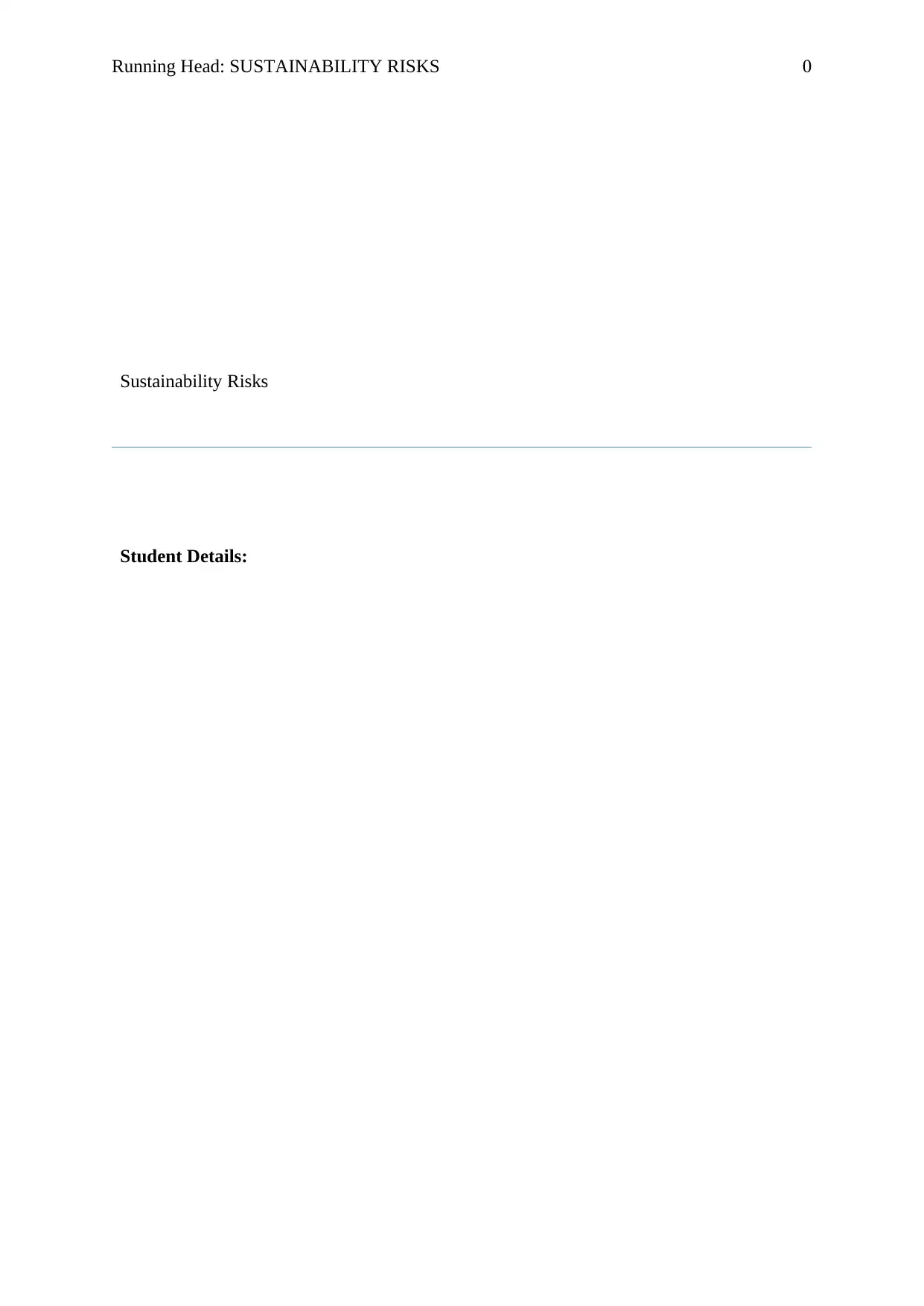
Running Head: SUSTAINABILITY RISKS 0
Sustainability Risks
Student Details:
Sustainability Risks
Student Details:
Paraphrase This Document
Need a fresh take? Get an instant paraphrase of this document with our AI Paraphraser
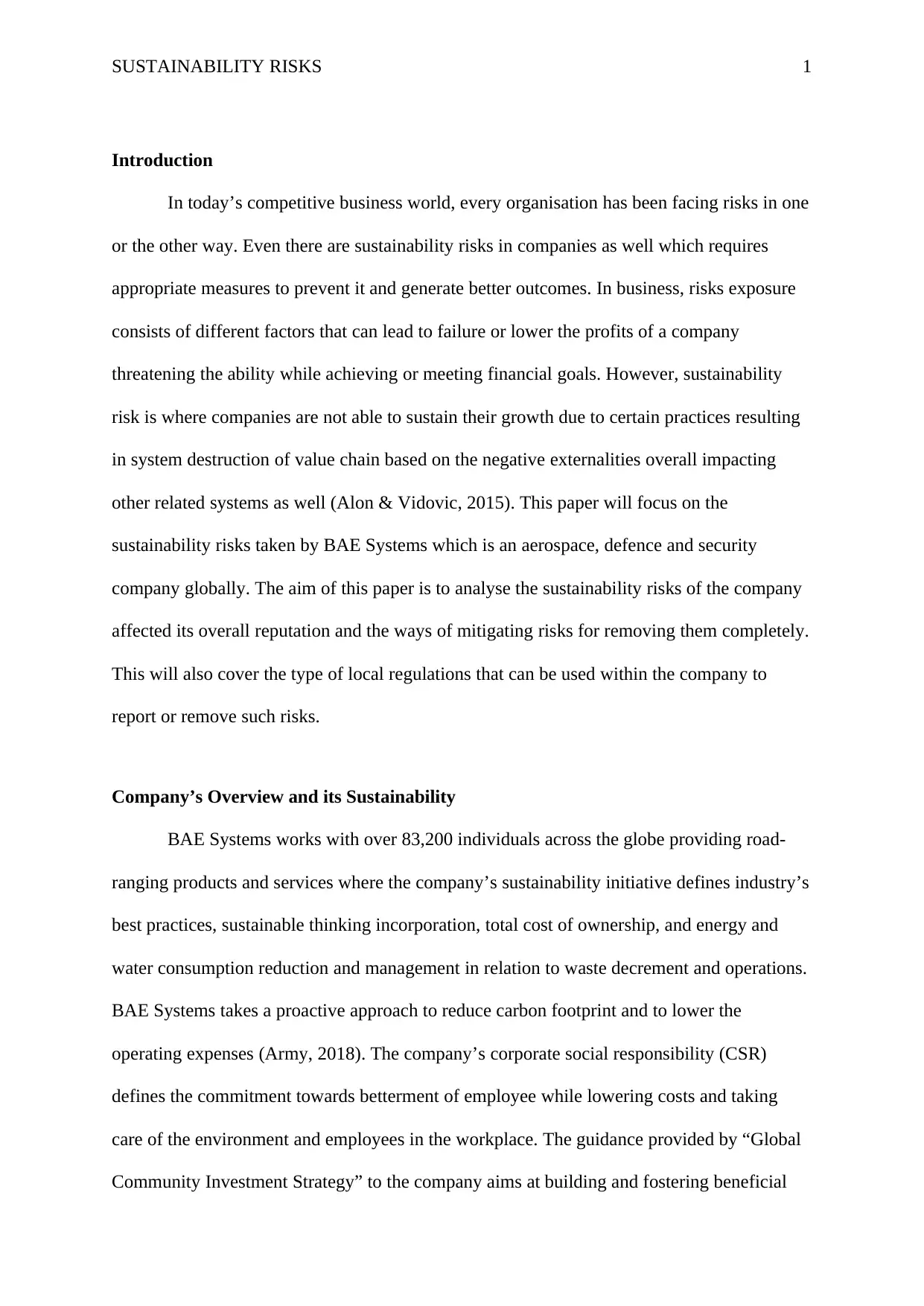
SUSTAINABILITY RISKS 1
Introduction
In today’s competitive business world, every organisation has been facing risks in one
or the other way. Even there are sustainability risks in companies as well which requires
appropriate measures to prevent it and generate better outcomes. In business, risks exposure
consists of different factors that can lead to failure or lower the profits of a company
threatening the ability while achieving or meeting financial goals. However, sustainability
risk is where companies are not able to sustain their growth due to certain practices resulting
in system destruction of value chain based on the negative externalities overall impacting
other related systems as well (Alon & Vidovic, 2015). This paper will focus on the
sustainability risks taken by BAE Systems which is an aerospace, defence and security
company globally. The aim of this paper is to analyse the sustainability risks of the company
affected its overall reputation and the ways of mitigating risks for removing them completely.
This will also cover the type of local regulations that can be used within the company to
report or remove such risks.
Company’s Overview and its Sustainability
BAE Systems works with over 83,200 individuals across the globe providing road-
ranging products and services where the company’s sustainability initiative defines industry’s
best practices, sustainable thinking incorporation, total cost of ownership, and energy and
water consumption reduction and management in relation to waste decrement and operations.
BAE Systems takes a proactive approach to reduce carbon footprint and to lower the
operating expenses (Army, 2018). The company’s corporate social responsibility (CSR)
defines the commitment towards betterment of employee while lowering costs and taking
care of the environment and employees in the workplace. The guidance provided by “Global
Community Investment Strategy” to the company aims at building and fostering beneficial
Introduction
In today’s competitive business world, every organisation has been facing risks in one
or the other way. Even there are sustainability risks in companies as well which requires
appropriate measures to prevent it and generate better outcomes. In business, risks exposure
consists of different factors that can lead to failure or lower the profits of a company
threatening the ability while achieving or meeting financial goals. However, sustainability
risk is where companies are not able to sustain their growth due to certain practices resulting
in system destruction of value chain based on the negative externalities overall impacting
other related systems as well (Alon & Vidovic, 2015). This paper will focus on the
sustainability risks taken by BAE Systems which is an aerospace, defence and security
company globally. The aim of this paper is to analyse the sustainability risks of the company
affected its overall reputation and the ways of mitigating risks for removing them completely.
This will also cover the type of local regulations that can be used within the company to
report or remove such risks.
Company’s Overview and its Sustainability
BAE Systems works with over 83,200 individuals across the globe providing road-
ranging products and services where the company’s sustainability initiative defines industry’s
best practices, sustainable thinking incorporation, total cost of ownership, and energy and
water consumption reduction and management in relation to waste decrement and operations.
BAE Systems takes a proactive approach to reduce carbon footprint and to lower the
operating expenses (Army, 2018). The company’s corporate social responsibility (CSR)
defines the commitment towards betterment of employee while lowering costs and taking
care of the environment and employees in the workplace. The guidance provided by “Global
Community Investment Strategy” to the company aims at building and fostering beneficial
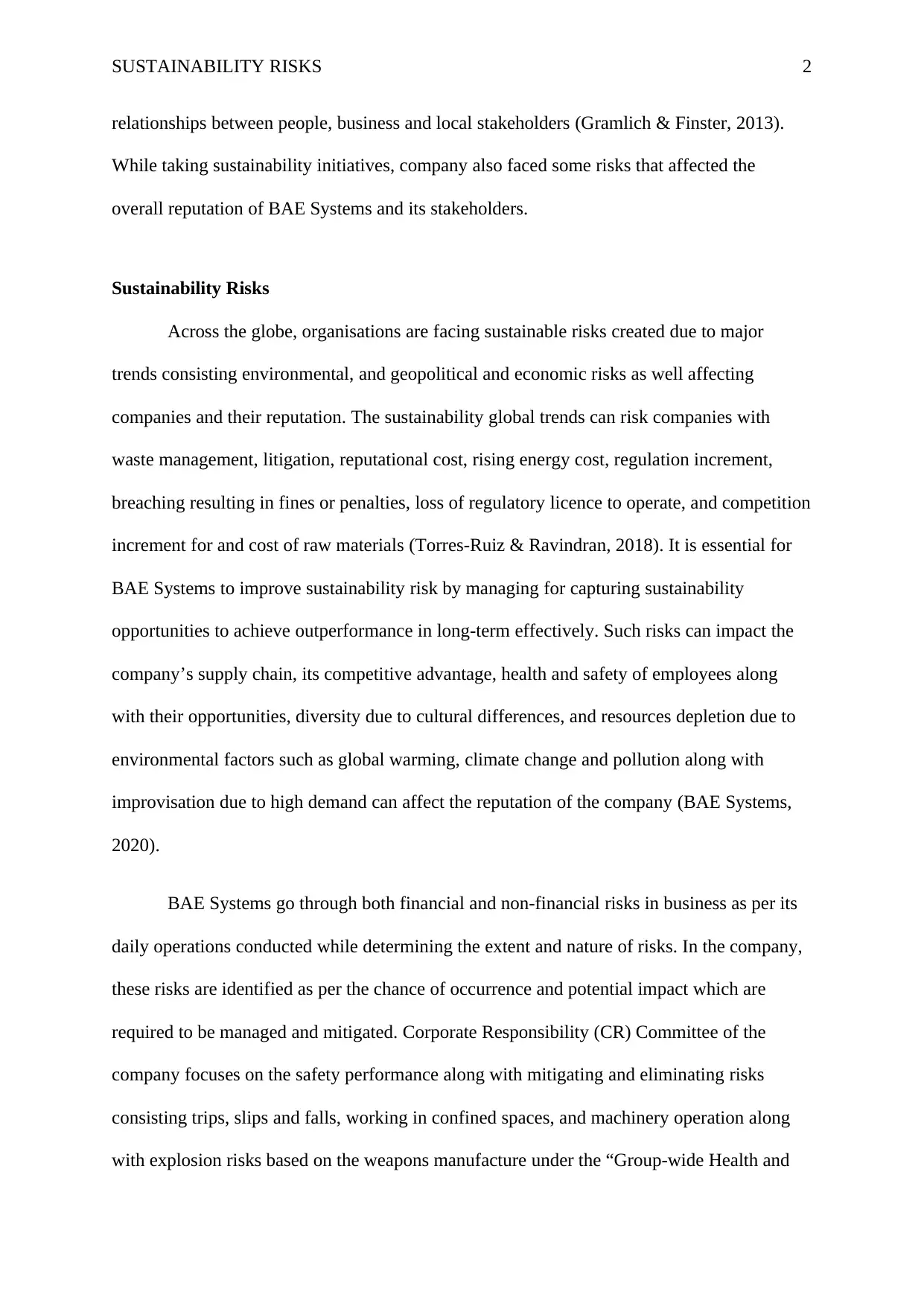
SUSTAINABILITY RISKS 2
relationships between people, business and local stakeholders (Gramlich & Finster, 2013).
While taking sustainability initiatives, company also faced some risks that affected the
overall reputation of BAE Systems and its stakeholders.
Sustainability Risks
Across the globe, organisations are facing sustainable risks created due to major
trends consisting environmental, and geopolitical and economic risks as well affecting
companies and their reputation. The sustainability global trends can risk companies with
waste management, litigation, reputational cost, rising energy cost, regulation increment,
breaching resulting in fines or penalties, loss of regulatory licence to operate, and competition
increment for and cost of raw materials (Torres-Ruiz & Ravindran, 2018). It is essential for
BAE Systems to improve sustainability risk by managing for capturing sustainability
opportunities to achieve outperformance in long-term effectively. Such risks can impact the
company’s supply chain, its competitive advantage, health and safety of employees along
with their opportunities, diversity due to cultural differences, and resources depletion due to
environmental factors such as global warming, climate change and pollution along with
improvisation due to high demand can affect the reputation of the company (BAE Systems,
2020).
BAE Systems go through both financial and non-financial risks in business as per its
daily operations conducted while determining the extent and nature of risks. In the company,
these risks are identified as per the chance of occurrence and potential impact which are
required to be managed and mitigated. Corporate Responsibility (CR) Committee of the
company focuses on the safety performance along with mitigating and eliminating risks
consisting trips, slips and falls, working in confined spaces, and machinery operation along
with explosion risks based on the weapons manufacture under the “Group-wide Health and
relationships between people, business and local stakeholders (Gramlich & Finster, 2013).
While taking sustainability initiatives, company also faced some risks that affected the
overall reputation of BAE Systems and its stakeholders.
Sustainability Risks
Across the globe, organisations are facing sustainable risks created due to major
trends consisting environmental, and geopolitical and economic risks as well affecting
companies and their reputation. The sustainability global trends can risk companies with
waste management, litigation, reputational cost, rising energy cost, regulation increment,
breaching resulting in fines or penalties, loss of regulatory licence to operate, and competition
increment for and cost of raw materials (Torres-Ruiz & Ravindran, 2018). It is essential for
BAE Systems to improve sustainability risk by managing for capturing sustainability
opportunities to achieve outperformance in long-term effectively. Such risks can impact the
company’s supply chain, its competitive advantage, health and safety of employees along
with their opportunities, diversity due to cultural differences, and resources depletion due to
environmental factors such as global warming, climate change and pollution along with
improvisation due to high demand can affect the reputation of the company (BAE Systems,
2020).
BAE Systems go through both financial and non-financial risks in business as per its
daily operations conducted while determining the extent and nature of risks. In the company,
these risks are identified as per the chance of occurrence and potential impact which are
required to be managed and mitigated. Corporate Responsibility (CR) Committee of the
company focuses on the safety performance along with mitigating and eliminating risks
consisting trips, slips and falls, working in confined spaces, and machinery operation along
with explosion risks based on the weapons manufacture under the “Group-wide Health and
⊘ This is a preview!⊘
Do you want full access?
Subscribe today to unlock all pages.

Trusted by 1+ million students worldwide
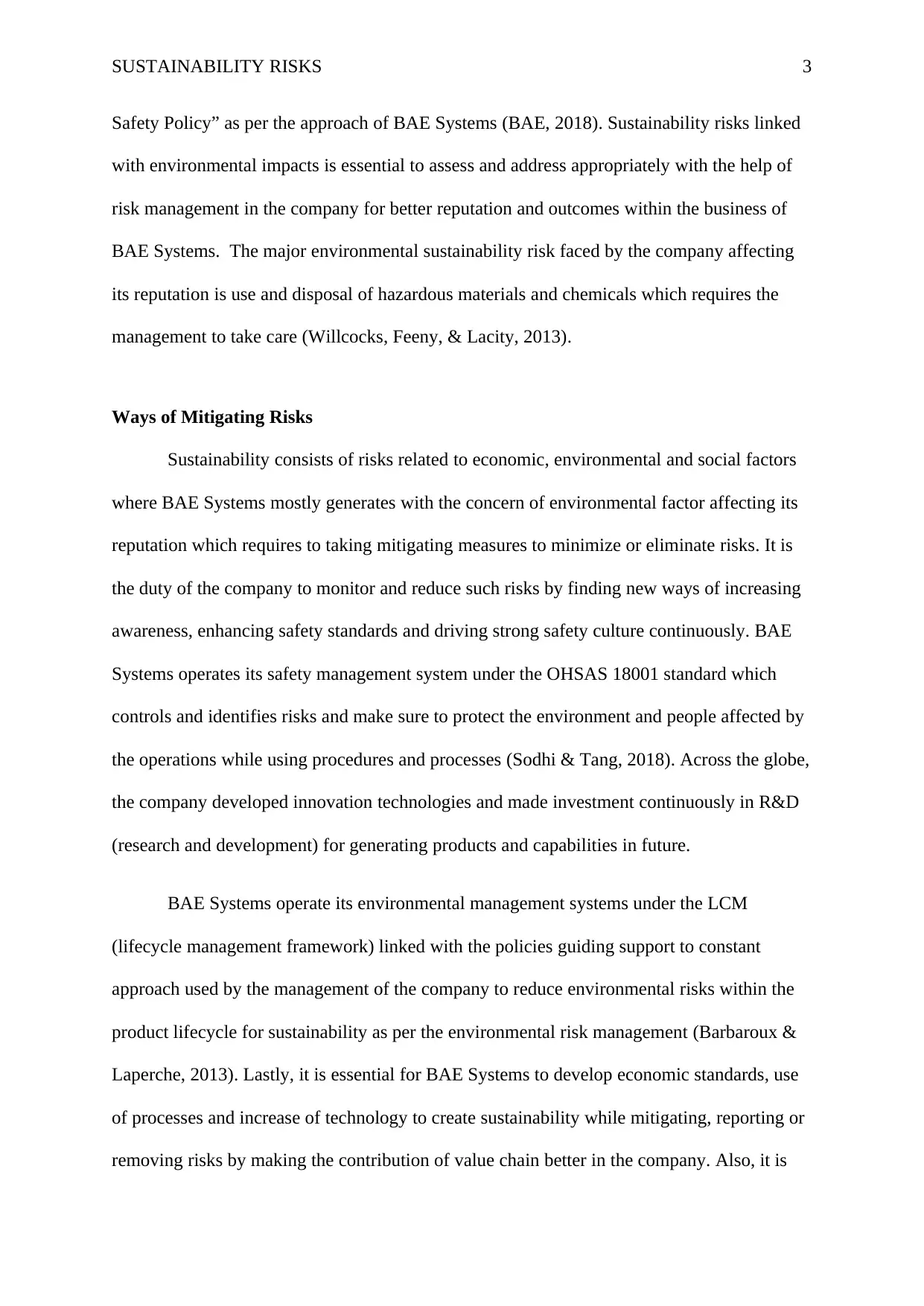
SUSTAINABILITY RISKS 3
Safety Policy” as per the approach of BAE Systems (BAE, 2018). Sustainability risks linked
with environmental impacts is essential to assess and address appropriately with the help of
risk management in the company for better reputation and outcomes within the business of
BAE Systems. The major environmental sustainability risk faced by the company affecting
its reputation is use and disposal of hazardous materials and chemicals which requires the
management to take care (Willcocks, Feeny, & Lacity, 2013).
Ways of Mitigating Risks
Sustainability consists of risks related to economic, environmental and social factors
where BAE Systems mostly generates with the concern of environmental factor affecting its
reputation which requires to taking mitigating measures to minimize or eliminate risks. It is
the duty of the company to monitor and reduce such risks by finding new ways of increasing
awareness, enhancing safety standards and driving strong safety culture continuously. BAE
Systems operates its safety management system under the OHSAS 18001 standard which
controls and identifies risks and make sure to protect the environment and people affected by
the operations while using procedures and processes (Sodhi & Tang, 2018). Across the globe,
the company developed innovation technologies and made investment continuously in R&D
(research and development) for generating products and capabilities in future.
BAE Systems operate its environmental management systems under the LCM
(lifecycle management framework) linked with the policies guiding support to constant
approach used by the management of the company to reduce environmental risks within the
product lifecycle for sustainability as per the environmental risk management (Barbaroux &
Laperche, 2013). Lastly, it is essential for BAE Systems to develop economic standards, use
of processes and increase of technology to create sustainability while mitigating, reporting or
removing risks by making the contribution of value chain better in the company. Also, it is
Safety Policy” as per the approach of BAE Systems (BAE, 2018). Sustainability risks linked
with environmental impacts is essential to assess and address appropriately with the help of
risk management in the company for better reputation and outcomes within the business of
BAE Systems. The major environmental sustainability risk faced by the company affecting
its reputation is use and disposal of hazardous materials and chemicals which requires the
management to take care (Willcocks, Feeny, & Lacity, 2013).
Ways of Mitigating Risks
Sustainability consists of risks related to economic, environmental and social factors
where BAE Systems mostly generates with the concern of environmental factor affecting its
reputation which requires to taking mitigating measures to minimize or eliminate risks. It is
the duty of the company to monitor and reduce such risks by finding new ways of increasing
awareness, enhancing safety standards and driving strong safety culture continuously. BAE
Systems operates its safety management system under the OHSAS 18001 standard which
controls and identifies risks and make sure to protect the environment and people affected by
the operations while using procedures and processes (Sodhi & Tang, 2018). Across the globe,
the company developed innovation technologies and made investment continuously in R&D
(research and development) for generating products and capabilities in future.
BAE Systems operate its environmental management systems under the LCM
(lifecycle management framework) linked with the policies guiding support to constant
approach used by the management of the company to reduce environmental risks within the
product lifecycle for sustainability as per the environmental risk management (Barbaroux &
Laperche, 2013). Lastly, it is essential for BAE Systems to develop economic standards, use
of processes and increase of technology to create sustainability while mitigating, reporting or
removing risks by making the contribution of value chain better in the company. Also, it is
Paraphrase This Document
Need a fresh take? Get an instant paraphrase of this document with our AI Paraphraser
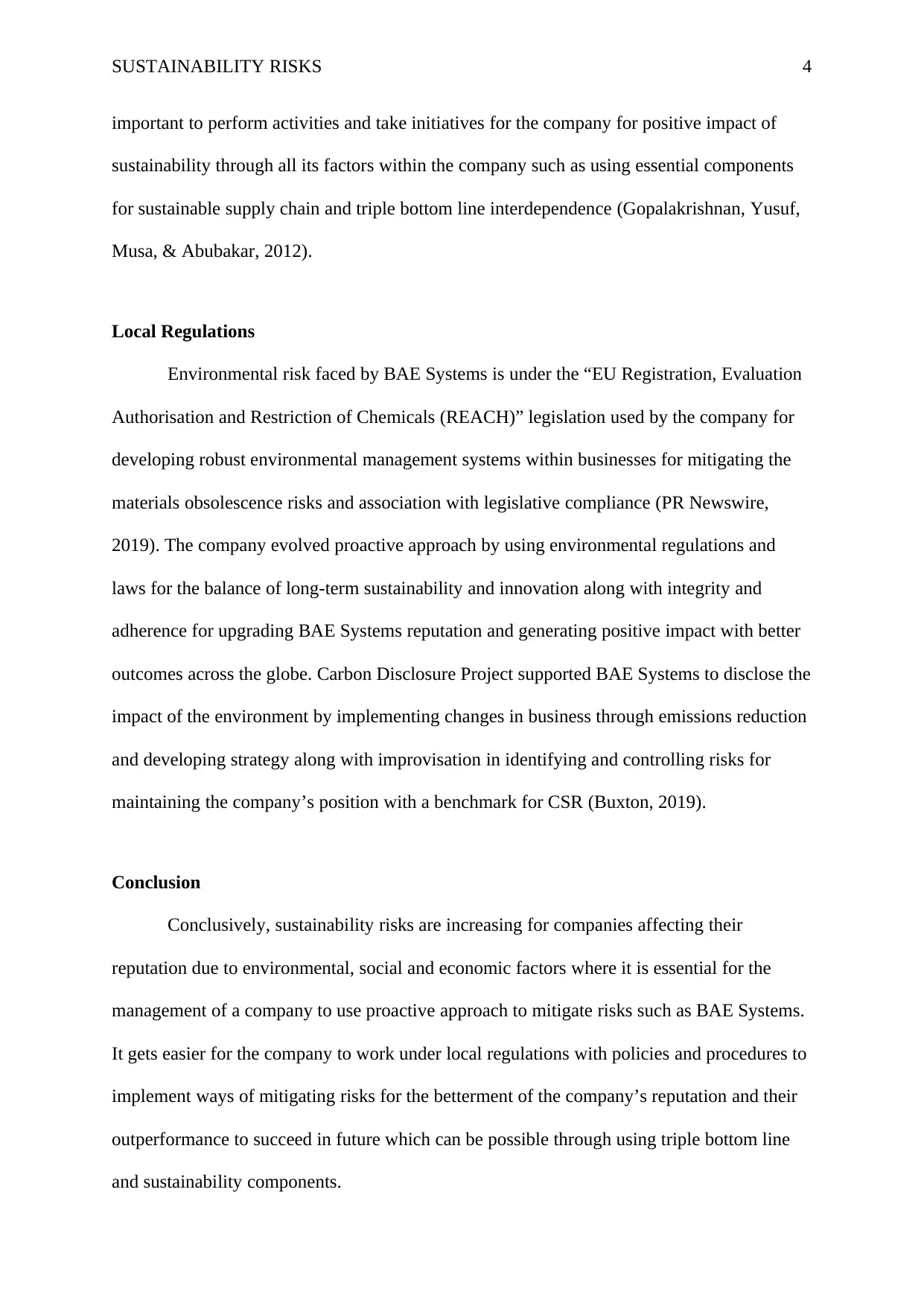
SUSTAINABILITY RISKS 4
important to perform activities and take initiatives for the company for positive impact of
sustainability through all its factors within the company such as using essential components
for sustainable supply chain and triple bottom line interdependence (Gopalakrishnan, Yusuf,
Musa, & Abubakar, 2012).
Local Regulations
Environmental risk faced by BAE Systems is under the “EU Registration, Evaluation
Authorisation and Restriction of Chemicals (REACH)” legislation used by the company for
developing robust environmental management systems within businesses for mitigating the
materials obsolescence risks and association with legislative compliance (PR Newswire,
2019). The company evolved proactive approach by using environmental regulations and
laws for the balance of long-term sustainability and innovation along with integrity and
adherence for upgrading BAE Systems reputation and generating positive impact with better
outcomes across the globe. Carbon Disclosure Project supported BAE Systems to disclose the
impact of the environment by implementing changes in business through emissions reduction
and developing strategy along with improvisation in identifying and controlling risks for
maintaining the company’s position with a benchmark for CSR (Buxton, 2019).
Conclusion
Conclusively, sustainability risks are increasing for companies affecting their
reputation due to environmental, social and economic factors where it is essential for the
management of a company to use proactive approach to mitigate risks such as BAE Systems.
It gets easier for the company to work under local regulations with policies and procedures to
implement ways of mitigating risks for the betterment of the company’s reputation and their
outperformance to succeed in future which can be possible through using triple bottom line
and sustainability components.
important to perform activities and take initiatives for the company for positive impact of
sustainability through all its factors within the company such as using essential components
for sustainable supply chain and triple bottom line interdependence (Gopalakrishnan, Yusuf,
Musa, & Abubakar, 2012).
Local Regulations
Environmental risk faced by BAE Systems is under the “EU Registration, Evaluation
Authorisation and Restriction of Chemicals (REACH)” legislation used by the company for
developing robust environmental management systems within businesses for mitigating the
materials obsolescence risks and association with legislative compliance (PR Newswire,
2019). The company evolved proactive approach by using environmental regulations and
laws for the balance of long-term sustainability and innovation along with integrity and
adherence for upgrading BAE Systems reputation and generating positive impact with better
outcomes across the globe. Carbon Disclosure Project supported BAE Systems to disclose the
impact of the environment by implementing changes in business through emissions reduction
and developing strategy along with improvisation in identifying and controlling risks for
maintaining the company’s position with a benchmark for CSR (Buxton, 2019).
Conclusion
Conclusively, sustainability risks are increasing for companies affecting their
reputation due to environmental, social and economic factors where it is essential for the
management of a company to use proactive approach to mitigate risks such as BAE Systems.
It gets easier for the company to work under local regulations with policies and procedures to
implement ways of mitigating risks for the betterment of the company’s reputation and their
outperformance to succeed in future which can be possible through using triple bottom line
and sustainability components.
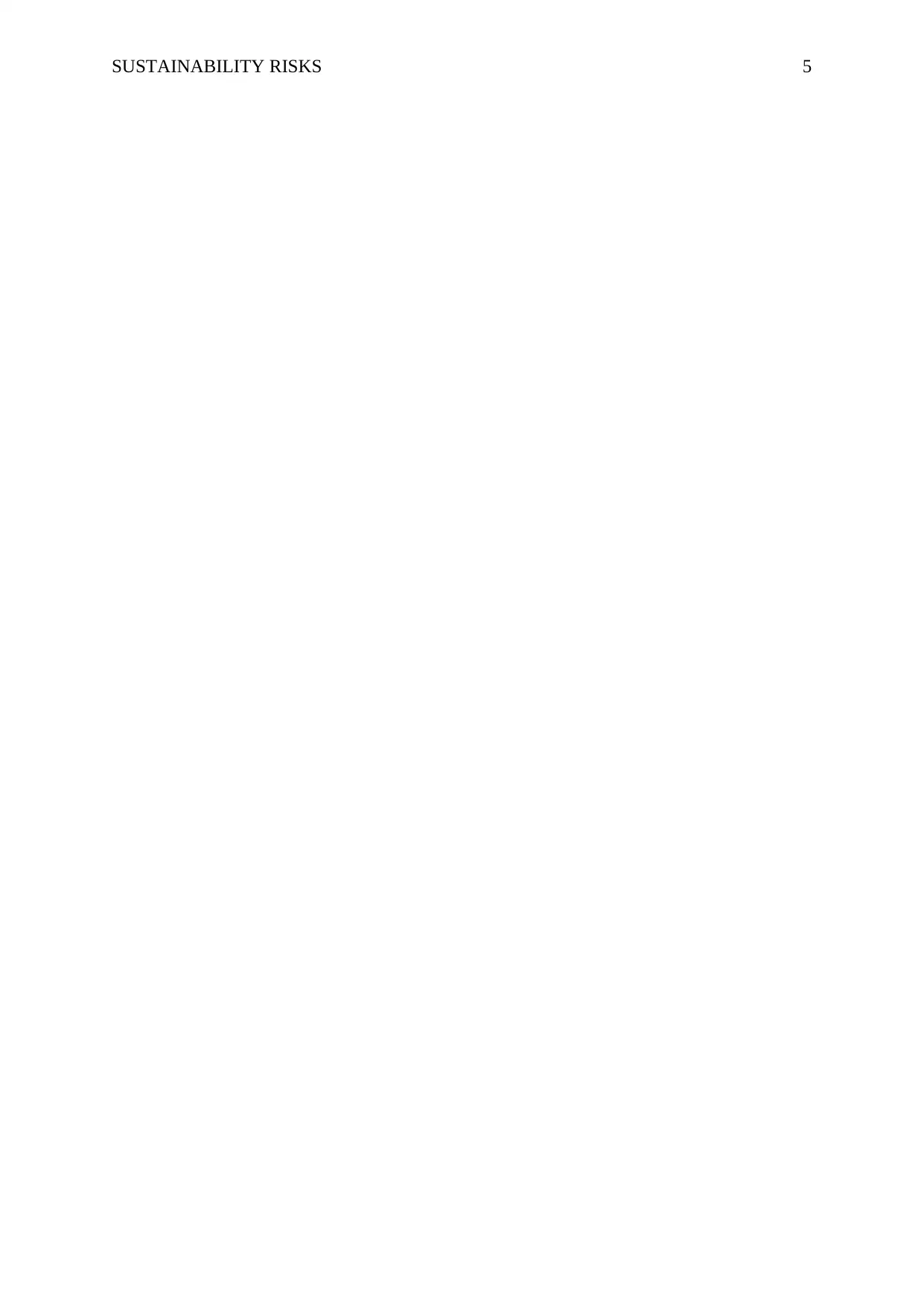
SUSTAINABILITY RISKS 5
⊘ This is a preview!⊘
Do you want full access?
Subscribe today to unlock all pages.

Trusted by 1+ million students worldwide
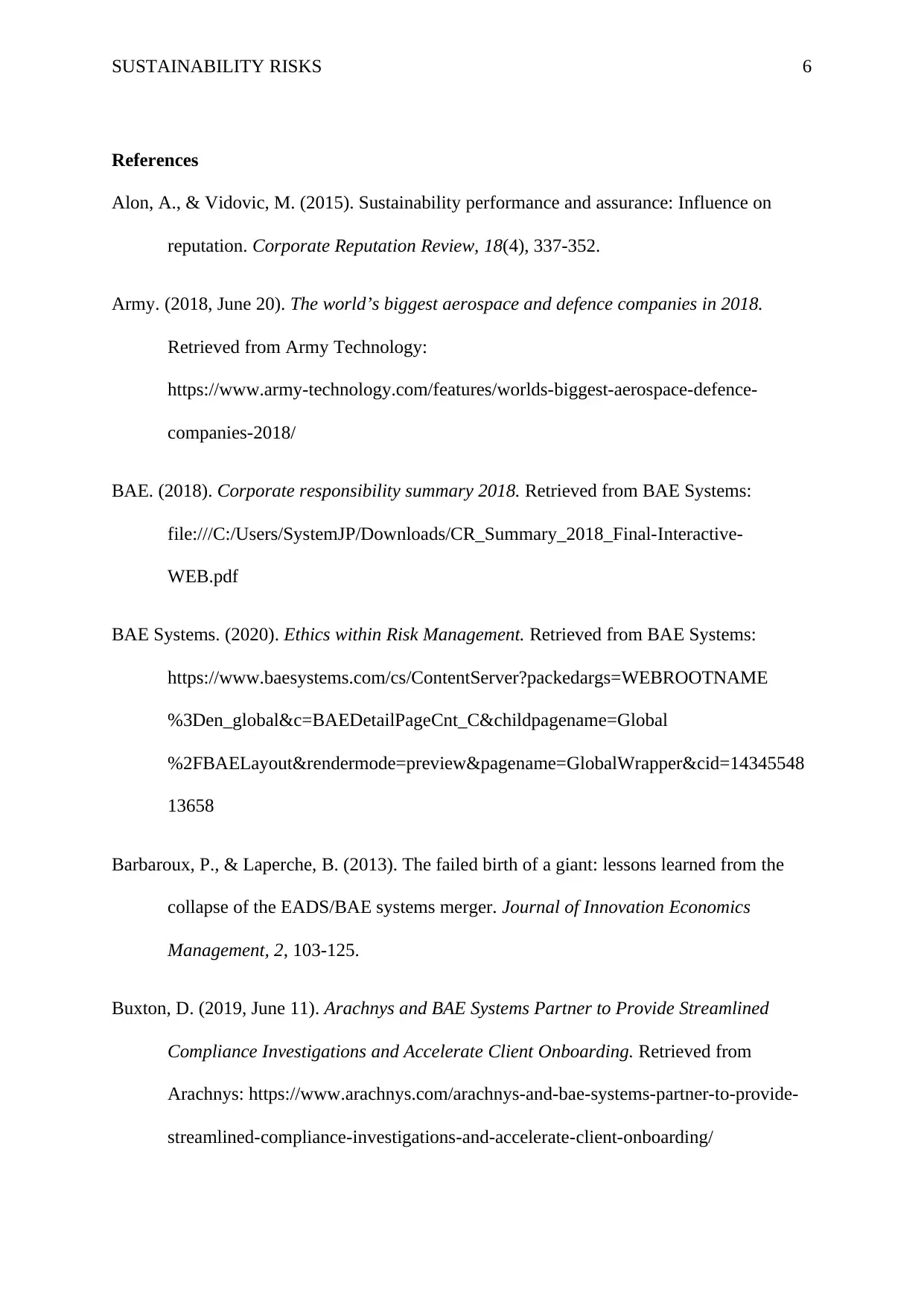
SUSTAINABILITY RISKS 6
References
Alon, A., & Vidovic, M. (2015). Sustainability performance and assurance: Influence on
reputation. Corporate Reputation Review, 18(4), 337-352.
Army. (2018, June 20). The world’s biggest aerospace and defence companies in 2018.
Retrieved from Army Technology:
https://www.army-technology.com/features/worlds-biggest-aerospace-defence-
companies-2018/
BAE. (2018). Corporate responsibility summary 2018. Retrieved from BAE Systems:
file:///C:/Users/SystemJP/Downloads/CR_Summary_2018_Final-Interactive-
WEB.pdf
BAE Systems. (2020). Ethics within Risk Management. Retrieved from BAE Systems:
https://www.baesystems.com/cs/ContentServer?packedargs=WEBROOTNAME
%3Den_global&c=BAEDetailPageCnt_C&childpagename=Global
%2FBAELayout&rendermode=preview&pagename=GlobalWrapper&cid=14345548
13658
Barbaroux, P., & Laperche, B. (2013). The failed birth of a giant: lessons learned from the
collapse of the EADS/BAE systems merger. Journal of Innovation Economics
Management, 2, 103-125.
Buxton, D. (2019, June 11). Arachnys and BAE Systems Partner to Provide Streamlined
Compliance Investigations and Accelerate Client Onboarding. Retrieved from
Arachnys: https://www.arachnys.com/arachnys-and-bae-systems-partner-to-provide-
streamlined-compliance-investigations-and-accelerate-client-onboarding/
References
Alon, A., & Vidovic, M. (2015). Sustainability performance and assurance: Influence on
reputation. Corporate Reputation Review, 18(4), 337-352.
Army. (2018, June 20). The world’s biggest aerospace and defence companies in 2018.
Retrieved from Army Technology:
https://www.army-technology.com/features/worlds-biggest-aerospace-defence-
companies-2018/
BAE. (2018). Corporate responsibility summary 2018. Retrieved from BAE Systems:
file:///C:/Users/SystemJP/Downloads/CR_Summary_2018_Final-Interactive-
WEB.pdf
BAE Systems. (2020). Ethics within Risk Management. Retrieved from BAE Systems:
https://www.baesystems.com/cs/ContentServer?packedargs=WEBROOTNAME
%3Den_global&c=BAEDetailPageCnt_C&childpagename=Global
%2FBAELayout&rendermode=preview&pagename=GlobalWrapper&cid=14345548
13658
Barbaroux, P., & Laperche, B. (2013). The failed birth of a giant: lessons learned from the
collapse of the EADS/BAE systems merger. Journal of Innovation Economics
Management, 2, 103-125.
Buxton, D. (2019, June 11). Arachnys and BAE Systems Partner to Provide Streamlined
Compliance Investigations and Accelerate Client Onboarding. Retrieved from
Arachnys: https://www.arachnys.com/arachnys-and-bae-systems-partner-to-provide-
streamlined-compliance-investigations-and-accelerate-client-onboarding/
Paraphrase This Document
Need a fresh take? Get an instant paraphrase of this document with our AI Paraphraser
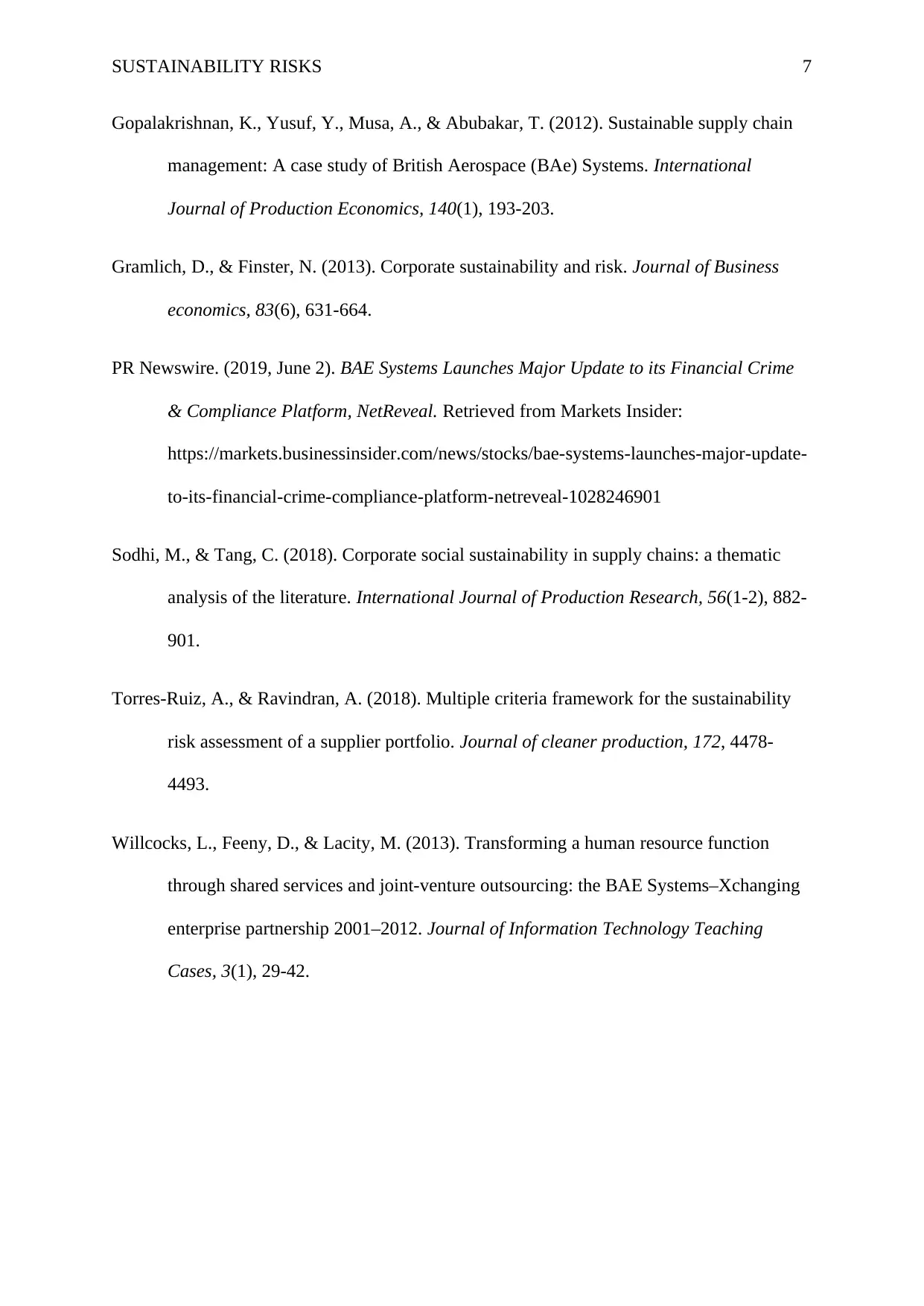
SUSTAINABILITY RISKS 7
Gopalakrishnan, K., Yusuf, Y., Musa, A., & Abubakar, T. (2012). Sustainable supply chain
management: A case study of British Aerospace (BAe) Systems. International
Journal of Production Economics, 140(1), 193-203.
Gramlich, D., & Finster, N. (2013). Corporate sustainability and risk. Journal of Business
economics, 83(6), 631-664.
PR Newswire. (2019, June 2). BAE Systems Launches Major Update to its Financial Crime
& Compliance Platform, NetReveal. Retrieved from Markets Insider:
https://markets.businessinsider.com/news/stocks/bae-systems-launches-major-update-
to-its-financial-crime-compliance-platform-netreveal-1028246901
Sodhi, M., & Tang, C. (2018). Corporate social sustainability in supply chains: a thematic
analysis of the literature. International Journal of Production Research, 56(1-2), 882-
901.
Torres-Ruiz, A., & Ravindran, A. (2018). Multiple criteria framework for the sustainability
risk assessment of a supplier portfolio. Journal of cleaner production, 172, 4478-
4493.
Willcocks, L., Feeny, D., & Lacity, M. (2013). Transforming a human resource function
through shared services and joint-venture outsourcing: the BAE Systems–Xchanging
enterprise partnership 2001–2012. Journal of Information Technology Teaching
Cases, 3(1), 29-42.
Gopalakrishnan, K., Yusuf, Y., Musa, A., & Abubakar, T. (2012). Sustainable supply chain
management: A case study of British Aerospace (BAe) Systems. International
Journal of Production Economics, 140(1), 193-203.
Gramlich, D., & Finster, N. (2013). Corporate sustainability and risk. Journal of Business
economics, 83(6), 631-664.
PR Newswire. (2019, June 2). BAE Systems Launches Major Update to its Financial Crime
& Compliance Platform, NetReveal. Retrieved from Markets Insider:
https://markets.businessinsider.com/news/stocks/bae-systems-launches-major-update-
to-its-financial-crime-compliance-platform-netreveal-1028246901
Sodhi, M., & Tang, C. (2018). Corporate social sustainability in supply chains: a thematic
analysis of the literature. International Journal of Production Research, 56(1-2), 882-
901.
Torres-Ruiz, A., & Ravindran, A. (2018). Multiple criteria framework for the sustainability
risk assessment of a supplier portfolio. Journal of cleaner production, 172, 4478-
4493.
Willcocks, L., Feeny, D., & Lacity, M. (2013). Transforming a human resource function
through shared services and joint-venture outsourcing: the BAE Systems–Xchanging
enterprise partnership 2001–2012. Journal of Information Technology Teaching
Cases, 3(1), 29-42.
1 out of 8
Related Documents
Your All-in-One AI-Powered Toolkit for Academic Success.
+13062052269
info@desklib.com
Available 24*7 on WhatsApp / Email
![[object Object]](/_next/static/media/star-bottom.7253800d.svg)
Unlock your academic potential
Copyright © 2020–2025 A2Z Services. All Rights Reserved. Developed and managed by ZUCOL.





